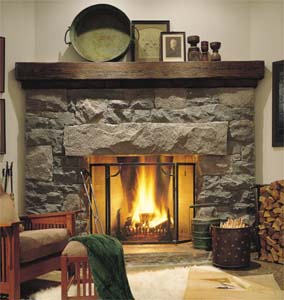|
Masonry fireplaces require an
extensive footing capable of supporting their great bulk, and if not
provided with one will often shift and crack, allowing the fire to
escape to nearby combustibles. You should always keep an eye out for
any signs of settling or movement. Just inside the firebox, where
the facing material meets the firebrick, is one weak spot where this
settling is often first apparent. Keeping downspouts directed away
from the fireplace and careful sloping of the ground around the
fireplace to be sure water runs away from the structure can keep
settling problems to a minimum.
|

|
Although masonry is quite
durable, and in fact is often seen as indestructible, this is
certainly not the case, especially for a chimney. While the rest of
the brick on the house is somewhat protected by the eave, the poor
chimney is sticking up like a flagpole, exposed to every raindrop
and freeze/thaw cycle. A quality chimney cover, keeping the crown in
good repair, and a waterproofing treatment, are money well spent to
avoid expensive repairs or rebuilding. See the section on
waterproofing
for a more detailed explanation.
The firebox of course takes
the brunt of the fires' heat and it requires some special attention.
The firebrick can take the heat pretty well, but the fireclay joints
will fail in time from the constant expansion and contraction. In a
fireplace without a chimney cover, the rain water will also pool on
the smoke shelf, mix with the soot behind the damper, and form an
acidic slurry that seeps into the fireback destroying the mortar
joints. These joints must be kept in good repair with a high
temperature refractory mortar to insure the fire is contained.
The tile liners used in most
masonry fireplaces are just fine as long as the fireplace is
properly maintained and not exposed to chimney fires. One good
chimney fire will usually crack these tiles, rendering them
incapable of performing their intended function. The general rule of
thumb is that a masonry fireplace should be cleaned before 1/4" of
soot accumulates. If you ever do experience a chimney fire, it is
very important to have the chimney cleaned and carefully evaluated
before it is used again. We suggest a side trip to the areas on Chimney
Fires and Liners for further information.
Unlike prefabricated
fireplaces which are factory engineered products, a masonry
fireplace is built on site brick by brick, giving the mason ultimate
control of the final product. This results in a wide range of
masonry fireplaces available, from long lasting, heat producing
beauties, to smoky pits that crumble in a relatively short time.
Most masonry fireplaces that chimney sweeps encounter, although far
from perfect, can, with a little tender loving care, and carefully
considered maintenance procedures, provide you with many peaceful,
relaxing hours in an otherwise often hectic world.
|







